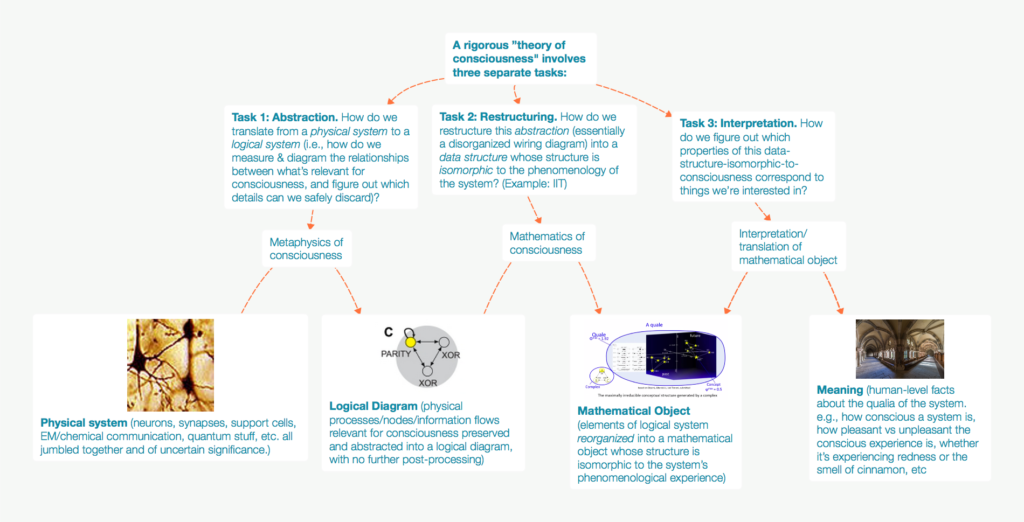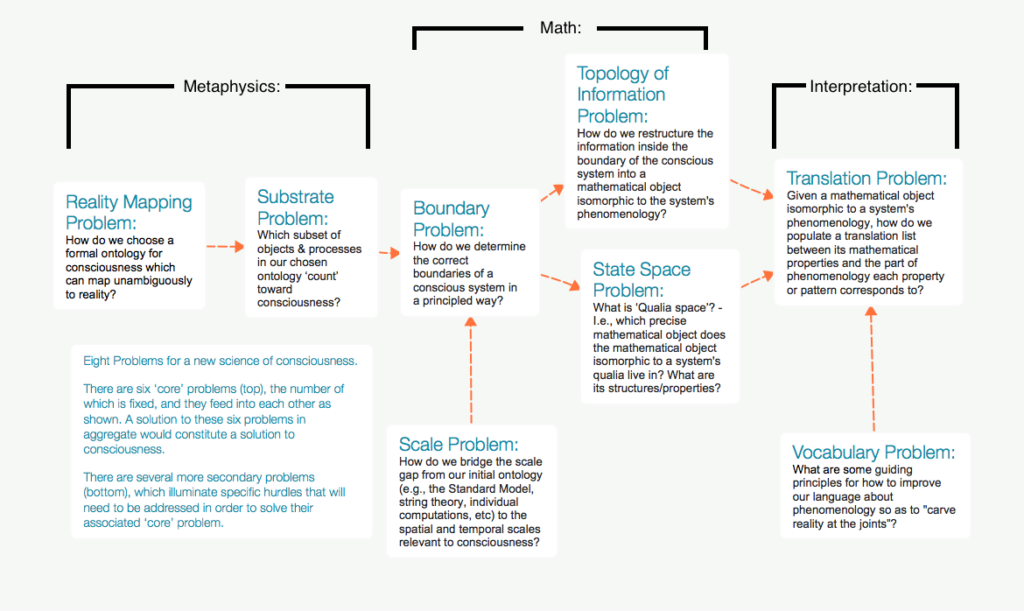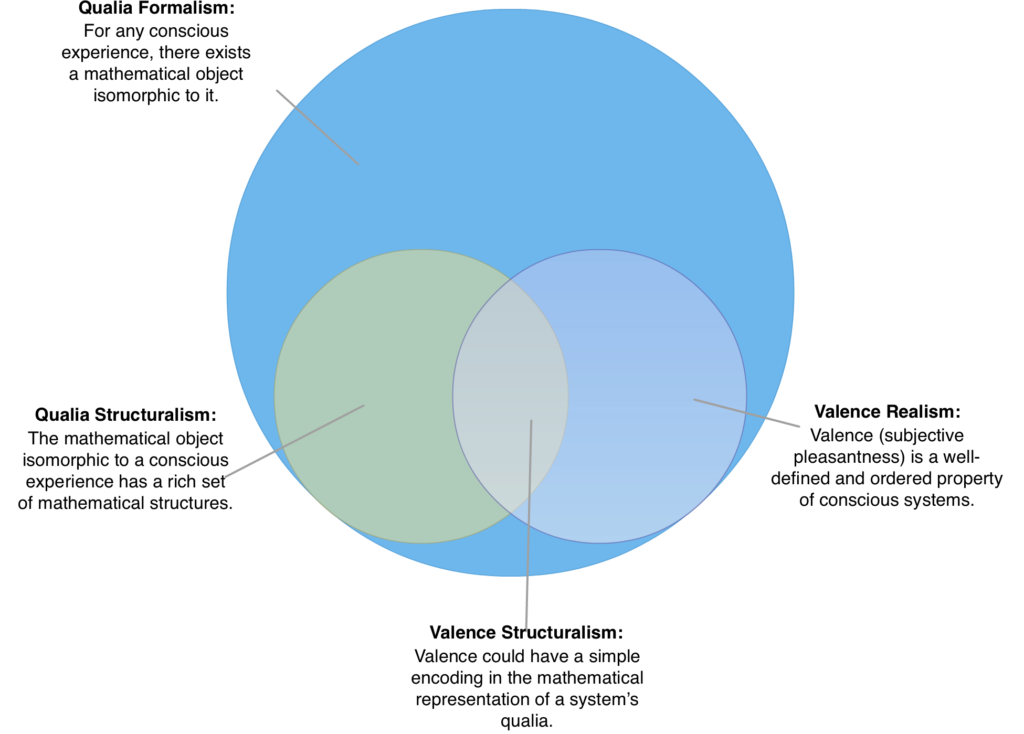Put simply, Principia Qualia (click for full version) is a blueprint for building a new Science of Qualia.
PQ begins by considering a rather modest question: what is emotional valence? What makes some things feel better than others?
This sounds like the sort of clear-cut puzzle affective neuroscience should be able to solve, yet all existing answers to this question are incoherent or circular. Giulio Tononi’s Integrated Information Theory (IIT) is an example of the kind of quantitative theory which could in theory address valence in a principled way, but unfortunately the current version of IIT is both flawed and incomplete. I offer a framework to resolve generalize IIT by distilling the problem of consciousness into eight discrete & modular sub-problems (of which IIT directly addresses five).
Finally, I return to valence, and offer a crisp, falsifiable hypothesis as to what it is in terms of something like IIT’s output, and discuss novel implications for neuroscience.
The most important takeaways are:
- My “Eight Problems” framework is a blueprint for a “full-stack” science of consciousness & qualia. Addressing all eight problems is both necessary & sufficient for ‘solving’ consciousness.
- One of IIT’s core shortcomings is that it doesn’t give any guidance for what its output means. I offer some useful heuristics.
- Emotional valence could be the easiest quale to reverse-engineer– the “c. elegans of qualia.”
Section-by-section highlights:
I. Why some things feel better than others: the view from neuroscience (2600 words)
Affective neuroscience knows a lot about valence… but its knowledge is very haphazard, disorganized, and often circular. The techniques it uses are good at assembling data, but not so good at finding clear patterns in the data, or knowing what data to gather in the first place.
II. Clarifying the Problem of Valence (900 words)
It could be that there are no clean answers to be found, and this is the best we can do. But I don’t buy that- I think we’re just looking at it from the wrong level of abstraction.
To really get traction on the problem of what makes some things feel better than others, we need to look for universal principles true in all conscious systems, not just things that are often true in the human brain.
This also implies that any attempt to solve valence which tries to avoid addressing the larger mystery of consciousness simply won’t work.
III. The Integrated Information Theory of consciousness (1900 words)
IIT is an attempt at a fully quantitative theory of consciousness. Think of it like a mathematical translation function: give it a system (like the brain), and it gives you a mathematical representation of what it feels like to be that system. It’s currently the best (and only) attempt at a full theory of consciousness we have.
IV. Critiques of IIT (2600 words)
Unfortunately, the current iteration of IIT is probably wrong, and definitely incomplete. There are some problems with its math, it’s a little vague on what its input should be, and it says almost nothing about what its output means.
V. Alternative versions of IIT: Perceptronium and FIIH (1500 words)
Other people are trying to translate IIT’s math into the language of physics in order to fix these problems. Unfortunately, these attempts are mostly stuck at the ‘idea’ stage.
VI. Summary and synthesis: eight problems for a new science of consciousness (900 words)
(Sections I-V are a literature review; Sections VI onward are original work.)
Even if IIT is wrong, we can use it as a template for understanding what tasks a theory of consciousness should be able to do:
Secondly, these categories break down into well-defined sub-problems:
Solve all eight problems, and you’ve solved consciousness. (Easy, right??)
VII. Three principles for a mathematical derivation of valence (1000 words)
IIT’s general approach implies that the problem of valence is a problem of mathematical interpretation: i.e.,
“Given a mathematical representation of my qualia (e.g., IIT’s output), what mathematical property of this representation corresponds to how pleasant it feels to be me?”
Here’s a Venn Diagram of assumptions:
(I explain each of these further in the paper.)
VIII. Distinctions in qualia: charting the explanation space for valence (1000 words)
If valence is some mathematical property of IIT’s output (or some future version of IIT which addresses its flaws), then what kind of property should we look for?
Here’s the clever heuristic: if we assume consciousness has a mathematical representation, then for any distinction you can make about qualia, you get a corresponding distinction in the domain of mathematics ‘for free’. And vice-versa! We can use this to explore what kind of mathematical property valence could correspond with:
- Valence seems global rather than local: when you eat a candy bar, everything feels good, not just your mouth;
- Valence seems simple rather than complex: i.e., in terms of Kolmogorov complexity;
- Valence seems atomic rather than composite: it’s a building block for more complex emotions;
- Valence seems intuitively important rather than intuitively trivial: it’s hard to miss.
Why this matters: if valence is [global,simple,atomic,intuitively important], then its mathematical representation is too. This significantly narrows the search space.
IX. Summary of heuristics for reverse-engineering the pattern for valence (2000 words)
This is a “throw everything but the kitchen sink at the problem” section: let’s list facts that we know, and clever heuristics, and hope some patterns emerge. Friston’s Free Energy Principle, Seth’s Predictive Error Minimization, Smolensky’s Computational Harmony metric, and my own “Non-adaptedness Principle” all make an appearance here. Also, I have this neat triangle graphic describing the state space of valence (it’s not just a one-dimensional pain-pleasure axis):
X. A simple hypothesis about valence (2000 words)
There’s a lot of context in the paper that I can’t give justice to in this summary- but given a mathematical object isomorphic to a system’s qualia, I think I’ve identified the mathematical property which corresponds to its valence. This property is the object’s symmetry.
XI. Testing this hypothesis today (1700 words)
Obviously, a hypothesis is only as good as the predictions it makes. I propose three specific tests:
(1) More pleasant brain states should be more compressible (as measured by zipping EEG data, controlling for degree of consciousness);
(2) Low-power rhythmic TMS of consciousness centers such as the thalamus at consonant frequencies should feel dramatically better than such stimulation at subtly dissonant frequencies;
(3) Similarly, consonant stimulation of the vagus nerve should feel better than stimulation with dissonant patterns (upshot: possibly testable with consumer-grade gear).
XII. Taking stock (1800 words)
If I’m right that symmetry in the mathematical object isomorphic to a conscious experience maps to valence, it allows us to recontextualize certain things in neuroscience in interesting ways. For instance:
On the anatomy & network topology of valence:
My hypothesis strongly implies that ‘hedonic’ brain regions influence mood by virtue of acting as ‘tuning knobs’ for symmetry/harmony in the brain’s consciousness centers. Likewise, nociceptors, and the brain regions which gate & interpret their signals, will be located at critical points in brain networks, able to cause large amounts of salience-inducing antisymmetry very efficiently. We should also expect rhythm to be a powerful tool for modeling brain dynamics involving valence- for instance, we should be able to extend (Safron 2016)’s model of rhythmic entrainment in orgasm to other sorts of pleasure.
More speculatively…
On valence & neuropharmacology:
Non-opioid painkillers and anti-depressants are complex, but it may turn out that a core mechanism by which they act is by introducing noise into neural activity and connectivity, respectively. This would explain the odd findings that acetaminophen blunts acute pleasure (Durso, Luttrell, and Way 2015), and that anti-depressants can induce long-term affective flattening.
This would also predict that psychedelic substances, although often pleasurable, actually increase emotional variance by biasing the brain toward symmetrical structure, and could result in enhanced pain if this structure is then broken– i.e., they are in this sense the opposite of painkillers. Additionally, we may find that some uncomfortable sensations are caused by ‘competing symmetries’- patterns that are internally symmetrical but not symmetrical to each other, which would predict complex and sometimes destructive interactions between different normally-pleasurable activities and psychoactives.
Furthermore, I would anticipate that severe tinnitus could lead to affective flattening for similar interference-based reasons: insofar as the brain’s subconscious preprocessing can’t tune it out, the presence of a constant pattern in consciousness would likely make it more difficult to generate symmetries (valence) on-the-fly. This would also imply that the specific frequency pattern of the perceived tinnitus sensation may matter more than is commonly assumed.
On self-organization & deep learning:
My hypothesis implies that symmetry/harmony is a core component of the brain’s organizational & computational syntax: specifically, we should think of symmetry as one (of many) dynamic attractors in the brain.
This suggests that mammals got a bit lucky that we evolved to seek out pleasure! But not that lucky, since symmetry is a very functionally-relevant anduseful property for systems to self-organize around, for at least two reasons:
First, self-organizing systems such as the brain must develop some way to perform error-correction, measure & maintain homeostasis, and guide & constrain morphological development. Symmetry-as-a-dynamic-attractor is a profoundly powerful solution to all of these which could evolve in incrementally-useful forms, and so symmetry-seeking seems like a common, perhaps nigh-universal evolutionary path to take. Indeed, it might be exceedingly difficult to develop a system with complex adaptive traits without heavy reliance upon principles of symmetry.
Second, the brain embodies principles of symmetry because it’s an efficient structure for modeling our world. (Lin and Tegmark 2016) note that physics and deep learning neural networks display cross-domain parallels such as “symmetry, locality, compositionality and polynomial log-probability”, and that deep learning can often avoid combinatorial explosion due to the fact that the physical world has lots of predictable symmetries, which enable unusually efficient neural network encoding schemes.
On Boredom:
Why do we find pure order & symmetry boring, and not particularly beautiful? I posit boredom is a very sophisticated “anti-wireheading” technology which prevents the symmetry/pleasure attractor basin from being too ‘sticky’, and may be activated by an especially low rate of Reward Prediction Errors (RPEs). Musical features which add mathematical variations or imperfections to the structure of music– e.g., syncopated rhythms (Witek et al. 2014), vocal burrs, etc– seem to make music more addictive and allows us to find long-term pleasure in listening to it, by hacking the mechanic(s) by which the brain implements boredom.
XIII. Closing thoughts (200 words)
I’ve used valence as a ‘pilot project’, but ultimately, the goal is to build a full Science of Qualia — something that can turn qualia research from alchemy into chemistry, and unify our different modes of knowing in neuroscience.
—
If this intrigues you, I suggest checking out the full paper.





2 thoughts on “Principia Qualia: the executive summary”
Comments are closed.